So far in this series we have talked about so many different groups of inputs and how I process them through my waves rack on any given event. While this is a series based on guidelines, I sincerely hope that this has sparked at least an idea of how you could improve your mix with perhaps a new tool or a new way of thinking in regards to how you use your waves or plugin equipment. If you go to this link you can read all the previous posts in this series. This week, I’m going to address what I do with the rest of my drum kit. I started the series with the bass guitar and the kick and snare but I didn’t talk about toms or cymbals. Well, it’s finally time. Because my tom chains are identical I’m going to go through my actual chain for one tom and show you the principles that I’m using that you can apply to the rest of the toms. I don’t do much with the brass but wanted to show you one things that I am doing that you might find helpful.
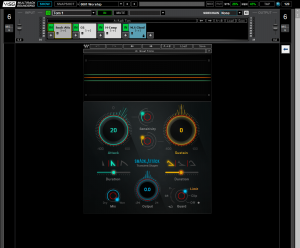 When Smack Attack was launched, we were in the market for something new for our toms in regards to not only physical equipment (i.e. triggers) but plugins as well. Let me tell you, this plugin fit the bill. With the option to adjust both the attack and the transients, we can really shape what the whole note sounds like. We currently don’t do a ton with the transient side of the plugin because of the gates we use on our consoles in conjunction with triggers on the drum to trigger those gates. However, before we started utilizing triggered gates, the transient side of the plugin was a pretty neat way to handle mixing toms without gates. With the graph over time you can really make sure you are getting the action that you want. So if you don’t want to gate opr maybe can’t afford or use triggers consider using smack attack. Both of them will considerably tighten up your mix. Just cleaning up the snare out of the first tom noticeably cleaned out drum reverbs in play and allowed me to really regain control of the drum-set. We aren’t talking total isolation, but enough that you really hear things tighten up. I am using an altered version of the “Great Toms” preset.
When Smack Attack was launched, we were in the market for something new for our toms in regards to not only physical equipment (i.e. triggers) but plugins as well. Let me tell you, this plugin fit the bill. With the option to adjust both the attack and the transients, we can really shape what the whole note sounds like. We currently don’t do a ton with the transient side of the plugin because of the gates we use on our consoles in conjunction with triggers on the drum to trigger those gates. However, before we started utilizing triggered gates, the transient side of the plugin was a pretty neat way to handle mixing toms without gates. With the graph over time you can really make sure you are getting the action that you want. So if you don’t want to gate opr maybe can’t afford or use triggers consider using smack attack. Both of them will considerably tighten up your mix. Just cleaning up the snare out of the first tom noticeably cleaned out drum reverbs in play and allowed me to really regain control of the drum-set. We aren’t talking total isolation, but enough that you really hear things tighten up. I am using an altered version of the “Great Toms” preset.
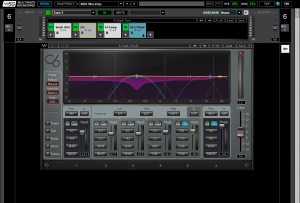 Secondly, I pulled up a C6. I have tried a bunch of the different presets but have altered so many so much I’ve basically developed my own now. A lot of the presets in the C6 are designed around studio usage but I’ve found that in the live environments they don’t often translate as they have way too much additive EQ for my tastes. So I went back to what I do with the C6 on everything else: build a curve based around the EQ I’m using on the channel and start from there. This is pretty much where I’ve landed. Because my EQs on toms are relatively simple (just a few cuts where needed, you always have to scoop out low mids and mids quite a bit with toms) my C6 curves aren’t complicated either. I grabbed one of the sweepable bands and moved it right to my big scoop from the board than started listening. I then setup some minor compression on the other bands and bypassed the top band because I just don’t need any compression up that high. The easiest way to do this is to get a recording or a really patient drummer that can just keep hitting the drum while you really take the time to dial it in. The hardest thing about toms is that you only hear them for a split second so you need to have your stuff together so take your time in setup. Also, I’ve found when I use the C6 or even the F6 in this way I can go back and adjust the EQ a little as I usually don’t need so much.
Secondly, I pulled up a C6. I have tried a bunch of the different presets but have altered so many so much I’ve basically developed my own now. A lot of the presets in the C6 are designed around studio usage but I’ve found that in the live environments they don’t often translate as they have way too much additive EQ for my tastes. So I went back to what I do with the C6 on everything else: build a curve based around the EQ I’m using on the channel and start from there. This is pretty much where I’ve landed. Because my EQs on toms are relatively simple (just a few cuts where needed, you always have to scoop out low mids and mids quite a bit with toms) my C6 curves aren’t complicated either. I grabbed one of the sweepable bands and moved it right to my big scoop from the board than started listening. I then setup some minor compression on the other bands and bypassed the top band because I just don’t need any compression up that high. The easiest way to do this is to get a recording or a really patient drummer that can just keep hitting the drum while you really take the time to dial it in. The hardest thing about toms is that you only hear them for a split second so you need to have your stuff together so take your time in setup. Also, I’ve found when I use the C6 or even the F6 in this way I can go back and adjust the EQ a little as I usually don’t need so much.
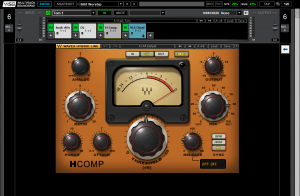 The last bit of compression I use on the toms is the HComp. I don’t generally like using the punch on my toms because it does some weird things with the tone of the attack in my case but I always play with this to make sure I don’t need it. As with my past suggestions, I’d set that threshold so that on the hardest hits you are taking around 6db out in compression. This is just a guideline but I’ve found it to be a good place to start. I use a standard ratio for drums (~8:1-10:1) and an attack that lets the drum pop but not make you blink and reasonably fast release so if multiple hits are happening we don’t end up adding compression on top of compression. I always want the compressor to fully release before the start of the next hit. My mix knob varies, for me it has a lot to do with who is playing. Strong players I can run it a bit higher, say 80% and above, but for more timid players or those who are new to the room I’ll turn this down to make sure that I still get plenty of life out of the set even from lighter players. I’ve also started adding some make-up gain back in to the tune of just a couple db to really make sure the toms jump to the top when they are hit and then disappear when they don’t.
The last bit of compression I use on the toms is the HComp. I don’t generally like using the punch on my toms because it does some weird things with the tone of the attack in my case but I always play with this to make sure I don’t need it. As with my past suggestions, I’d set that threshold so that on the hardest hits you are taking around 6db out in compression. This is just a guideline but I’ve found it to be a good place to start. I use a standard ratio for drums (~8:1-10:1) and an attack that lets the drum pop but not make you blink and reasonably fast release so if multiple hits are happening we don’t end up adding compression on top of compression. I always want the compressor to fully release before the start of the next hit. My mix knob varies, for me it has a lot to do with who is playing. Strong players I can run it a bit higher, say 80% and above, but for more timid players or those who are new to the room I’ll turn this down to make sure that I still get plenty of life out of the set even from lighter players. I’ve also started adding some make-up gain back in to the tune of just a couple db to really make sure the toms jump to the top when they are hit and then disappear when they don’t.
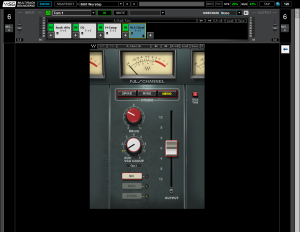 Last but not least for me is the NLS plugin. I decided awhile ago that I wanted to use the same model on all the drums to help them feel like they are one unit and so I have stuck with the Neve model. I love this model in general as it adds a bunch of clarity and spark that the other two just don’t have. I find myself playing around with this from time to time but always end up back on Nevo. Additionally, the NLS plugin is all that’s on the hi hat and ride inputs. I’ve tried compression or gating and never liked the results. These two inputs sit up and ungated and provide a lot of the space that my gated drum-set needs to sound natural. Also, because of the very wide dynamic range of these two cymbals, I generally don’t recommend much if any processing on them.
Last but not least for me is the NLS plugin. I decided awhile ago that I wanted to use the same model on all the drums to help them feel like they are one unit and so I have stuck with the Neve model. I love this model in general as it adds a bunch of clarity and spark that the other two just don’t have. I find myself playing around with this from time to time but always end up back on Nevo. Additionally, the NLS plugin is all that’s on the hi hat and ride inputs. I’ve tried compression or gating and never liked the results. These two inputs sit up and ungated and provide a lot of the space that my gated drum-set needs to sound natural. Also, because of the very wide dynamic range of these two cymbals, I generally don’t recommend much if any processing on them.
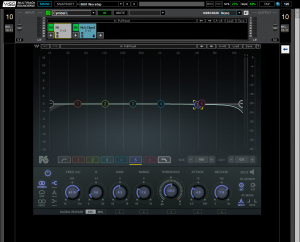 After we picked up the F6 that has 6 bands of dynamic EQ with high and low filters I immediately tried this on our cymbal inputs. In our 96k system controlling the high end is very important to us and so I dropped in a the F6 to dynamically pull this back. That way when the drummer really lays into the cymbals, like they do, while I don’t need to compress this I’m at least controlling the part of it that makes us all cringe, the high end shrill that starts around 8-10k and goes up to infinity. This has actually allowed me to be able to use the cymbals more because the part of the tone that when amplified hurts, is not being dealt with dynamically. I definitely don’t want to make any cuts during a ballad when we are looking for those intricate sounds from the brass of the set but rather only when we are in that huge bridge, the drummer is laying into the kit and then slams both crashes. This creates a subtle difference which, in my opinion, makes those moments better and more powerful because you are still focused on the song and not thinking about how loud the cymbals feel.
After we picked up the F6 that has 6 bands of dynamic EQ with high and low filters I immediately tried this on our cymbal inputs. In our 96k system controlling the high end is very important to us and so I dropped in a the F6 to dynamically pull this back. That way when the drummer really lays into the cymbals, like they do, while I don’t need to compress this I’m at least controlling the part of it that makes us all cringe, the high end shrill that starts around 8-10k and goes up to infinity. This has actually allowed me to be able to use the cymbals more because the part of the tone that when amplified hurts, is not being dealt with dynamically. I definitely don’t want to make any cuts during a ballad when we are looking for those intricate sounds from the brass of the set but rather only when we are in that huge bridge, the drummer is laying into the kit and then slams both crashes. This creates a subtle difference which, in my opinion, makes those moments better and more powerful because you are still focused on the song and not thinking about how loud the cymbals feel.
That’s it for this week. Next week I’m going to touch on my group bus chains next week and provide a few last minute resources for your benefit. I hope to see you back and as always, I hope that you are getting something out of all this information. If you have any questions or even an idea for me to try out please comment below or email me at daniel@studiostagelive.com. If you want to be sure not to miss a post, just follow this link and you will get an email as soon as new content is released. Happy mixing!
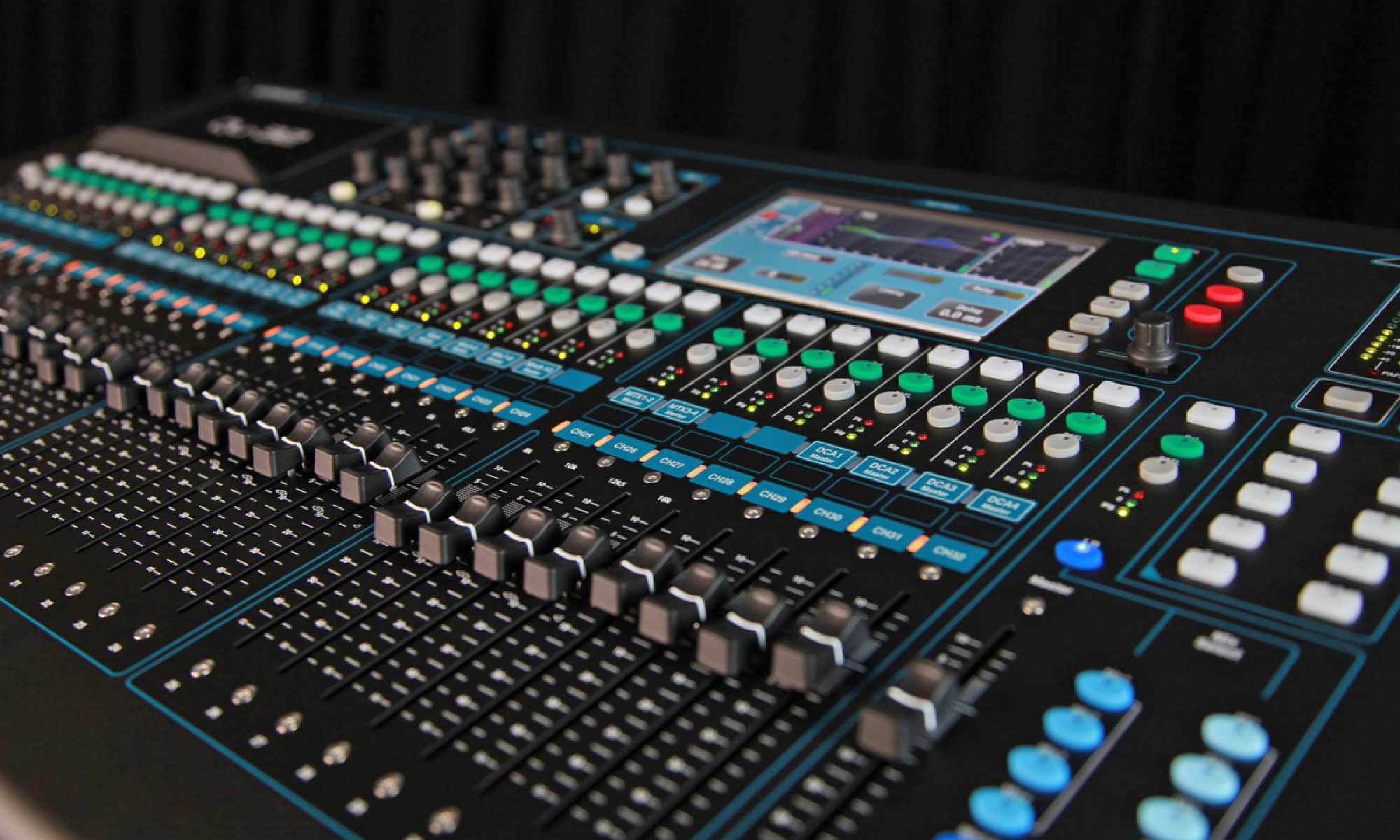
It would be nice to have audio samples to hear the difference between the chain active and inactive.
I’d like to do this but the logistics are difficult in this day and age. I’m hoping to figure something for that out soon. Plus when I’m mixing for a 1500 seat room it doesn’t necessarily sound good in headphones but I hear ya. I’m hoping to attach some of my channel presets next week or the week after. Thanks for the suggestion! Keep ’em coming!